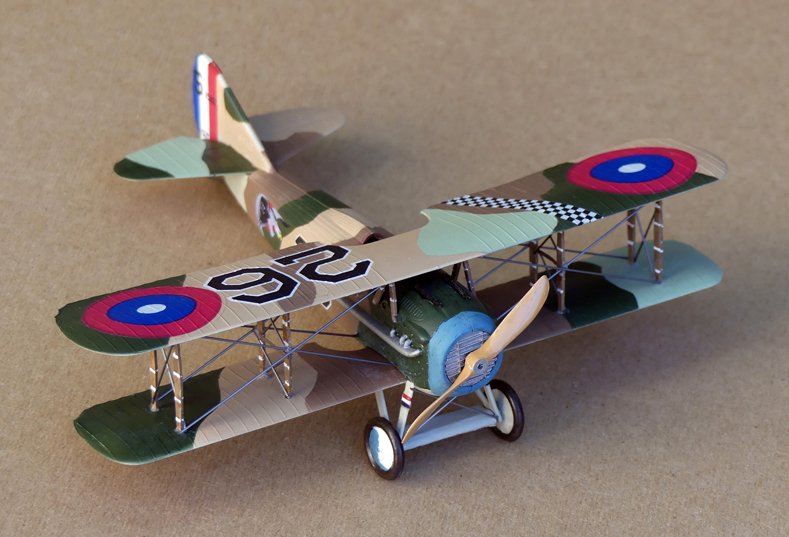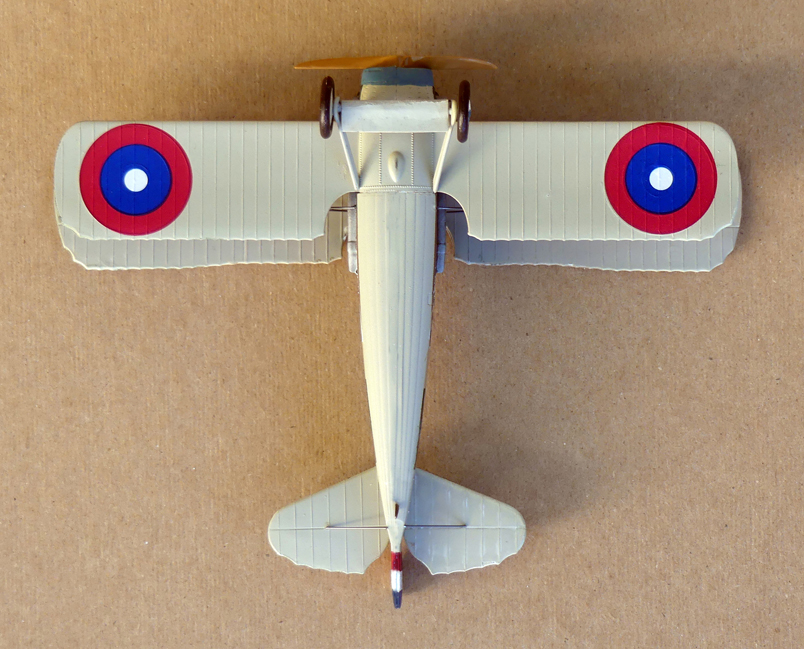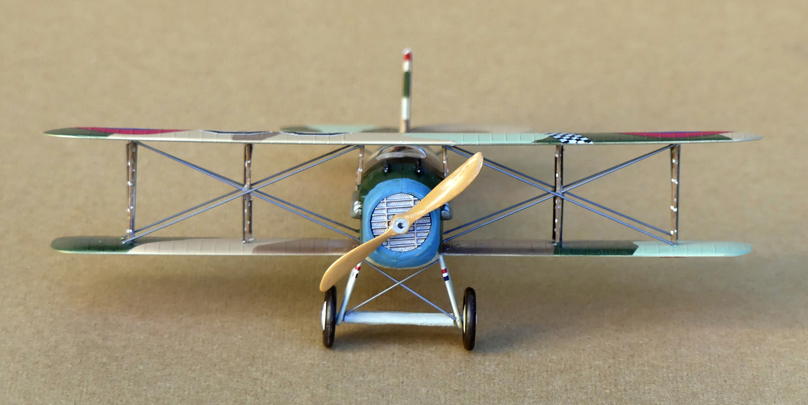 <><><>
<><><>
 <><><>
<><><>
In 1916 a new generation of German fighters threatened to win air superiority over the Western Front. The French aircraft company, Société pour l'Aviation et ses Dérives (SPAD), responded by developing a replacement for its highly successful SPAD VII. Louis Becheray designed an essentially larger version of the SPAD VII with a more powerful V-8 Hispano-Suiza engine. The prototype SPAD XIII C.1 ["C" designating Chasseur (fighter) and "1" indicating one aircrew] first flew in March 1917.
With its 220-hp engine, the SPAD XIII reached a top speed of 135 mph -- about 10 mph faster than the new German fighters. It carried two .303-cal. Vickers machine guns mounted above the engine. Each gun had 400 rounds of ammunition, and the pilot could fire the guns separately or together. Technical problems hampered production until late 1917, but nine different companies built a total of 8,472 SPAD XIIIs by the time production ceased in 1919.
Since the United States entered World War I without a combat-ready fighter of its own, the U.S. Army Air Service obtained fighters built by the Allies. After the Nieuport 28 proved unsuitable, the Air Service adopted the SPAD XIII as its primary fighter. By the war's end, the Air Service had accepted 893 SPAD XIIIs from the French, and these aircraft equipped 15 of the 16 American fighter squadrons. Today, Americans are most familiar with the SPAD XIII because many aces like Capt. Eddie Rickenbacker and Lt. Frank Luke, Jr. flew them during WW I.
Lt. Luke was credited with 19 aerial victories, ranking him second among United States Army Air Service pilots after Capt. Rickenbacker (26 aerial victories) during World War I. Between September 12 and September 29, 1918, Lt. Luke was credited with shooting down 14 German observation balloons and four airplanes. He achieved these 18 victories during just ten sorties in eight days, a feat unsurpassed by any pilot including Manfred von Richthofen in World War I. On September 29, 1918, Lt. Luke was hit by a single machine gun bullet fired from a hilltop above him and was able to land and walk 200 yards toward forest cover before dying. He was the first American aviator to be awarded the Medal of Honor. Luke AFB, Arizona is named after Lt. Luke, an Arizona native whose father emigrated from Germany.
The B&W photo is of Lt. Frank Luke, Jr. with his SPAD XIII on September 19, 1918. The color photo is of a SPAD XIII painted to represent the one flown by Lt. Frank Luke, Jr. The plane is approximately 80% original parts from several aircraft. It is one of five surviving today and is on display in Terminal 3 of Phoenix Sky Harbor Airport.
Facts and General Characteristics of the SPAD XIII C.1:
Contractor: Société pour l'Aviation et ses Dérives, France Facts and General Characteristics of the Model: This model has the markings of SPAD 15202 flown by Lt. Frank Luke, Jr. with the 27th Aero Squadron of the a United States Army Air Service that fought on the Western Front during World War I. The squadron was assigned as a Day Pursuit (Fighter) Squadron as part of the 1st Pursuit Group, First United States Army. Its mission was to engage and clear enemy aircraft from the skies and provide escort to reconnaissance and bombardment squadrons over enemy territory. It also attacked enemy observation balloons and performed close air support and tactical bombing attacks of enemy forces along the front lines. Manufacturer: Testors, USA Mistakes/Problems: I recently reread Capt. Eddie Rickenbacker’s autobiography and wanted to build a model of the SPAD he flew during WW I. That model is no longer made in 1/48 scale which is the scale I build all airplane models in. I was able to purchase an old (late 1970’s) 1/48 scale, unbuilt model kit on eBay. After I built and airbrush painted the model, I found the decals with Rickenbacker’s markings were unusable. Because of their age, they disintegrated after being dipped in water. I could not locate any aftermarket decals depicting Rickenbacker’s markings, so I purchased decals with a choice of four different SPAD markings. I chose the decals for Lt. Frank Luke, Jr.’s SPAD. These new decals worked great except for the French flag colors marking. It didn’t cover the whole vertical stabilizer so I had to fill in with paint. The model is not very detailed so I manufactured some extra parts that didn’t come with the kit: a wind screen, machine gun barrels, the “wing” between the wheels and the wire support cables. I didn’t use the pilot because it didn’t look very realistic. I broke the landing gear axle in two parts and fixed that with super glue.
Type: Fighter
Crew: One
Wingspan: 27 ft. 1 in. (8.25 m), late examples had a span of 26.5 ft. (8.08 m)
Length: 20 ft. 6 in. (6.25 m)
Height: 8 ft. 6 in. (2.6 m)
Weight: Empty 1,326 lbs. (601.5 kg), Max Takeoff 1,888 lbs. (856.5 kg)
Power Plant: 1 × Hispano-Suiza 8Ba, Bb or Bd Water cooled 8-cylinder vee-type, 200 hp (150 kW)
Max Speed: 131 mph (211 km/h) at 3,300 ft. (1,000 m)
Ceiling: 22,300 ft. (6,800 m)
Endurance: 2 hours
Armament:
Scale: 1/48
Wingspan: 6.6”
Length: 5.25”
Height: 1.75”
Parts: 32 (not including wire support cables)
Hours to build and paint: 12.7







Four of the top fighters of World War 1. Left to right: SPAD XIII C.1 (France),
Sopwith F.1 Camel (Great Britain), Fokker Dr.1 and Fokker D.VII (Germany).